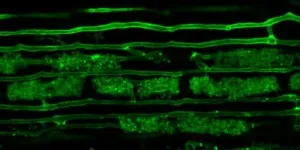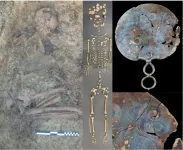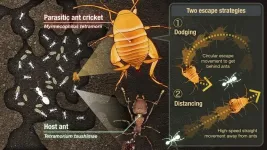(Press-News.org) While most known types of DNA damage are fixed by our cells’ in-house DNA repair mechanisms, some forms of DNA damage evade repair and can persist for many years, new research shows. This means that the damage has multiple chances to generate harmful mutations, which can lead to cancer.
Scientists from the Wellcome Sanger Institute and their collaborators analysed family trees of hundreds of single cells from several individuals. The team pieced together these family trees from patterns of shared mutations between the cells, indicating common ancestors.
Researchers uncovered unexpected patterns of mutation inheritance in the trees, revealing that some DNA damage persists unrepaired. In the case of blood stem cells, this can be for two to three years.
The research, published today (15 January) in Nature, changes the way we think about mutations, and has implications for understanding the development of various cancers.
Throughout our life, all of the cells in our body accumulate genetic errors in the genome, known as somatic mutations. These can be caused by damaging environmental exposures, such as smoking, as well as the everyday chemistry occurring in our cells.
DNA damage is distinct from a mutation. While a mutation is one of the standard four DNA bases (A, G, T or C) in the wrong place, similar to a spelling mistake, DNA damage is chemical alteration of the DNA, like a smudged unrecognisable letter. DNA damage can result in the genetic sequence being misread and copied during cell division – known as DNA replication – and this introduces permanent mutations that can contribute to the development of cancers. However, the DNA damage itself is usually recognised and mended quickly by repair mechanisms in our cells.
If researchers can better understand the causes and mechanisms of mutations, they may be able to intervene and slow or remove them.
In a new study, Sanger Institute scientists and their collaborators analysed data in the form of family trees of hundreds of single cells from individuals. The family trees are constructed from patterns of mutations across the genome that are shared between cells – for example, cells with many shared mutations have a recent common ancestor cell and are closely related.
The researchers collated seven published sets of these family trees, known as somatic phylogenies. The data set included 103 phylogenies from 89 individuals1, spanning blood stem cells, bronchial epithelial cells and liver cells.
The team found unexpected patterns of mutation inheritance in the family trees, revealing that some DNA damage can persist unrepaired through multiple rounds of cell division. This was particularly evident in blood stem cells, where between 15 to 20 per cent of the mutations resulted from a specific type of DNA damage that persists for two to three years on average, and in some cases longer.
This means that during cell division, each time the cell attempts to copy the damaged DNA it can make a different mistake, leading to multiple different mutations from a single source of DNA damage. Importantly, this creates multiple chances of harmful mutations that could contribute to cancer. Researchers suggest that although these types of DNA damage occur rarely, their persistence over years means they can cause as many mutations as more common DNA damage.
Overall, these findings change the way researchers think about mutations, and has implications for the development of cancer.
Dr Michael Spencer Chapman, first author from the Wellcome Sanger Institute and the Barts Cancer Institute, said: “With these family trees, we can link the relationships of hundreds of cells from one person right back to conception, meaning we can track back through the divisions each cell has gone through. It’s these large-scale, novel datasets that have led us to this unexpected finding that some forms of DNA damage can last for a long time without being repaired. This study is a prime example of exploratory science – you don't always know what you're going to find until you look; you have to stay curious.”
Emily Mitchell, an author from the Wellcome Sanger Institute, Wellcome-MRC Cambridge Stem Cell Institute and University of Cambridge, said: “When exploring family trees of blood stem cells in particular, we found a specific type of DNA damage that results in around 15 to 20 per cent of the mutations in these cells, and can last for several years. It is unclear why this process is only found in blood stem cells and not other healthy tissues. Knowing that the DNA damage is long-lasting gives new routes to investigate what the damage actually is. As we continue to better understand the causes of mutations, we may one day be able to intervene and remove them.”
Dr Peter Campbell, lead author previously from the Wellcome Sanger Institute and now Chief Scientific Officer at Quotient Therapeutics, said: “We have identified forms of DNA damage that manage to escape our DNA repair mechanisms and persist in the genome for days, months, or sometimes years. These findings don’t fit with what scientists have previously thought about the fundamentals of how mutations are acquired. This paradigm shift brings a new dimension to the way we think about mutations, and is important for the research community when designing future studies.”
ENDS
Contact details:
Emily Mobley
Press Office
Wellcome Sanger Institute
Cambridge, CB10 1SA
Email: press.office@sanger.ac.uk
Notes to Editors:
Donors included healthy adults, stem cell transplant donors and recipients, blood cancer patients with myeloproliferative neoplasms, and chemotherapy-exposed patients.
Publication:
Michael Spencer Chapman et al. (2025) ‘Prolonged persistence of mutagenic DNA lesions in somatic cells.’ Nature. DOI: 10.1038/s41586-024-08423-8
Funding:
This research was supported by Wellcome, Cancer Research UK and others. Full details can be found in the publication.
Selected websites:
The Wellcome Sanger Institute
The Wellcome Sanger Institute is a world leader in genomics research. We apply and explore genomic technologies at scale to advance understanding of biology and improve health. Making discoveries not easily made elsewhere, our research delivers insights across health, disease, evolution and pathogen biology. We are open and collaborative; our data, results, tools, technologies and training are freely shared across the globe to advance science.
Funded by Wellcome, we have the freedom to think long-term and push the boundaries of genomics. We take on the challenges of applying our research to the real world, where we aim to bring benefit to people and society.
Find out more at www.sanger.ac.uk or follow us on Twitter, Instagram, Facebook, LinkedIn and on our Blog.
About Wellcome
Wellcome supports science to solve the urgent health challenges facing everyone. We support discovery research into life, health and wellbeing, and we’re taking on three worldwide health challenges: mental health, infectious disease and climate and health. https://wellcome.org/
END
DNA damage can last unrepaired for years, changing our view of mutations
In a paradigm shift in how we view mutations, researchers uncover forms of DNA damage in healthy cells that can persist unrepaired for years
2025-01-15
ELSE PRESS RELEASES FROM THIS DATE:
Could this fundamental discovery revolutionise fertiliser use in farming?
2025-01-15
Researchers have discovered a biological mechanism that makes plant roots more welcoming to beneficial soil microbes.
This discovery by John Innes Centre researchers paves the way for more environmentally friendly farming practices, potentially allowing farmers to use less fertiliser.
Production of most major crops relies on nitrate and phosphate fertilisers, but excessive fertiliser use harms the environment.
If we could use mutually beneficial relationships between plant roots and soil microbes to enhance nutrient uptake, ...
How one brain circuit encodes memories of both places and events
2025-01-15
CAMBRIDGE, MA -- Nearly 50 years ago, neuroscientists discovered cells within the brain’s hippocampus that store memories of specific locations. These cells also play an important role in storing memories of events, known as episodic memories. While the mechanism of how place cells encode spatial memory has been well-characterized, it has remained a puzzle how they encode episodic memories.
A new model developed by MIT researchers explains how those place cells can be recruited to form episodic memories, even when there’s no spatial component. According to this model, place cells, along with grid cells found in the entorhinal cortex, act as a scaffold ...
ASU-led collaboration receives $11.2 million to build a Southwest Regional Direct Air Capture Hub
2025-01-15
Arizona State University and a team of its collaborators have received $11.2 million in funding from the U.S. Department of Energy to begin developing a regional Direct Air Capture (DAC) Hub for removing carbon dioxide (CO2) from the atmosphere. The team will prepare to build a multi-site Direct Air Capture Hub located in the Four Corners area of the Southwestern United States. Additionally, the project will receive $11.2 million in matching funds from the project partners.
In May of 2022, the Biden administration announced the Bipartisan Infrastructure Law’s $3.5 billion DOE program to establish large-scale Direct Air Capture Hubs for removing carbon ...
Study finds strategies to minimize acne recurrence after taking medication for severe acne
2025-01-15
Isotretinoin, commonly referred to as Accutane, is the only approved medical treatment capable of inducing long-term remission of severe acne. Although highly effective, some individuals experience recurrence of acne after a course of treatment. A new study from researchers at Mass General Brigham examined how often acne recurs after isotretinoin and what factors might put patients at risk of acne coming back. They found that acne recurrence necessitating treatment with an oral medication such as oral antibiotics, spironolactone, or another ...
Deep learning designs proteins against deadly snake venom
2025-01-15
New proteins not found in nature have now been designed to counteract certain highly poisonous components of snake venom. The deep learning, computational methods for developing these toxin-neutralizing proteins offer hope for creating safer, more cost-effective and more readily available therapeutics than those currently in use.
Each year more than 2 million people suffer snakebites. More than 100,000 of them die, according to the World Health Organization, and 300,000 suffer severe complications and lasting disability ...
A new geometric machine learning method promises to accelerate precision drug development
2025-01-15
Proteins are the foundation of all life we currently know. With their virtually limitless diversity, they can perform a broad variety of biological functions, from delivering oxygen to cells and acting as chemical messengers to defending the body against pathogens. Furthermore, most biochemical reactions are only possible thanks to enzymes, a special type of protein catalysts.
The molecular surface of proteins is the key to their function, such as docking small molecules or other proteins or driving ...
Ancient genomes reveal an Iron Age society centred on women
2025-01-15
An international team of geneticists, led by those from Trinity College Dublin, has joined forces with archaeologists from Bournemouth University to decipher the structure of British Iron Age society, finding evidence of female political and social empowerment.
The researchers seized upon a rare opportunity to sequence DNA from many members of a single community. They retrieved over 50 ancient genomes from a set of burial grounds in Dorset, southern England, in use before and after the Roman Conquest of AD 43. The results revealed that this community was centred around bonds of female-line descent.
Dr Lara Cassidy, Assistant Professor in Trinity’s Department of Genetics, led ...
How crickets co-exist with hostile ant hosts
2025-01-15
Researchers at Nagoya University in Japan have discovered sophisticated behavioral strategies that enable parasitic crickets to survive within ant colonies. Led by Ryoya Tanaka, the team documented how these insects successfully navigate life among potentially lethal hosts through precise evasion tactics. Their findings, published in Communications Biology, reveal remarkable adaptations that allow these cricket species to thrive in a hostile environment.
Animals that live in ant colonies, known as “ant guests”, exploit their hosts’ resources. However, this ...
Tapered polymer fibers enhance light delivery for neuroscience research
2025-01-15
WASHINGTON — Researchers have developed a reliable and reproducible way to fabricate tapered polymer optical fibers that can be used to deliver light to the brain. These fibers could be used in animal studies to help scientists better understand treatments and interventions for various neurological conditions.
The tapered fibers are optimized for neuroscience research techniques, such as optogenetic experiments and fiber photometry, which rely on the interaction between genetically modified neurons and visible light delivered to and/or collected from the brain.
“Unlike standard optical fibers, which are cylindrical, the tapered fibers we developed have a conical shape, which ...
Syracuse University’s Fran Brown named Paul “Bear” Bryant Newcomer Coach of the Year Award recipient
2025-01-15
HOUSTON, January 15, 2025 — The American Heart Association has named Syracuse University’s Fran Brown as the recipient of the 2024 Paul “Bear” Bryant Newcomer Coach of the Year Award. This award celebrates the achievements of an individual who has not had any previous head coaching experience at the NCAA Division I football sub-division (FBS) level.
Coach Brown will be recognized with the honor during the 2025 Bear Bryant Awards on January 22.
After being named Syracuse’s 31st head coach on November 28, 2023, Brown immediately instilled a culture of ...
LAST 30 PRESS RELEASES:
KAIST proposes AI-driven strategy to solve long-standing mystery of gene function
Eye for trouble: Automated counting for chromosome issues under the microscope
The vast majority of US rivers lack any protections from human activities, new research finds
Ultrasound-responsive in situ antigen "nanocatchers" open a new paradigm for personalized tumor immunotherapy
Environmental “superbugs” in our rivers and soils: new one health review warns of growing antimicrobial resistance crisis
Triple threat in greenhouse farming: how heavy metals, microplastics, and antibiotic resistance genes unite to challenge sustainable food production
Earthworms turn manure into a powerful tool against antibiotic resistance
AI turns water into an early warning network for hidden biological pollutants
Hidden hotspots on “green” plastics: biodegradable and conventional plastics shape very different antibiotic resistance risks in river microbiomes
Engineered biochar enzyme system clears toxic phenolic acids and restores pepper seed germination in continuous cropping soils
Retail therapy fail? Online shopping linked to stress, says study
How well-meaning allies can increase stress for marginalized people
Commercially viable biomanufacturing: designer yeast turns sugar into lucrative chemical 3-HP
Control valve discovered in gut’s plumbing system
George Mason University leads phase 2 clinical trial for pill to help maintain weight loss after GLP-1s
Hop to it: research from Shedd Aquarium tracks conch movement to set new conservation guidance
Weight loss drugs and bariatric surgery improve the body’s fat ‘balance:’ study
The Age of Fishes began with mass death
TB harnesses part of immune defense system to cause infection
Important new source of oxidation in the atmosphere found
A tug-of-war explains a decades-old question about how bacteria swim
Strengthened immune defense against cancer
Engineering the development of the pancreas
The Journal of Nuclear Medicine ahead-of-print tip sheet: Jan. 9, 2026
Mount Sinai researchers help create largest immune cell atlas of bone marrow in multiple myeloma patients
Why it is so hard to get started on an unpleasant task: Scientists identify a “motivation brake”
Body composition changes after bariatric surgery or treatment with GLP-1 receptor agonists
Targeted regulation of abortion providers laws and pregnancies conceived through fertility treatment
Press registration is now open for the 2026 ACMG Annual Clinical Genetics Meeting
Understanding sex-based differences and the role of bone morphogenetic protein signaling in Alzheimer’s disease
[Press-News.org] DNA damage can last unrepaired for years, changing our view of mutationsIn a paradigm shift in how we view mutations, researchers uncover forms of DNA damage in healthy cells that can persist unrepaired for years






